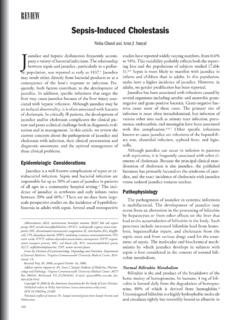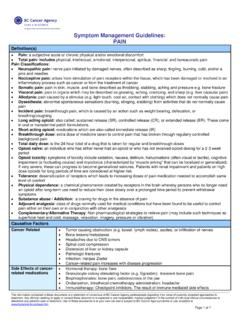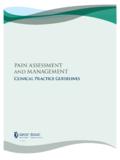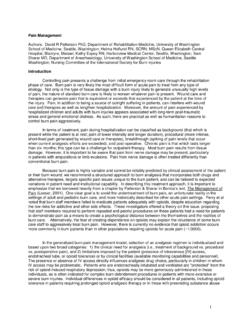Transcription of Assessment and Management of Chemical Coping …
1 Assessment and Management of Chemical Coping inPatients With CancerEgidio Del FabbroFrom Virginia Commonwealth Univer-sity, Massey Cancer Center, Richmond, online ahead of print on May 5, s disclosures of potential con-flicts of interest and author contribu-tions are found at the end of author: Egidio DelFabbro, MD, Palliative Care Program,Division of Hematology, Oncology andPalliative Care, Virginia CommonwealthUniversity, 1101 East Marshall St,Richmond, VA 23298-0230; 2014 by American Society of ClinicalOncology0732-183X/14/3216w-1734w /$ : Coping is a working definition that describes patients intake of opioids on a scale that spansthe range between normal nonaddictive opioid use for pain all the way to opioid addiction.
2 Mostpatients will fall somewhere between the two extremes in using opioid analgesics to cope with theirpsychological or spiritual distress. The degree to which patients use their medications in a maladaptivemanner will determine their susceptibility to drug toxicity and harm. When there are no obviouscancer-related causes for increased pain intensity, Chemical Coping and other patient-related factorssuch as delirium, somatization, and depression should be considered. As part of the initial evaluationof patients with cancer-related pain, a brief screening tool such as the CAGE questionnaire should beused to identify patients who may be at risk for Chemical Coping .
3 Identifying patients at risk will allowclinicians to avoid unnecessary opioid toxicity, control pain, and improve quality of life. A structuredapproach for managing opioid use should be adopted, including standardized documentation, opioidtreatment agreements, urine drug screens, frequent visits, and restricted quantities of breakthroughopioids. All patients at risk should receive brief motivational interviewing with an objective, nonjudg-mental, and empathic style that includes personalized feedback, particularly about markers of risk orharm.
4 For Chemical copers approaching the addiction end of the spectrum, with evidence ofcompulsive use and destructive behavior, referral should be made to substance abuse Clin Oncol 32:1734-1738. 2014 by American Society of Clinical OncologyINTRODUCTIONMany patients treated for cancer have a high symp-tom burden, regardless of whether they are at theend of life or early in the cancer to severe levels of pain are reported in approxi-mately 15% of ambulatory patients with cancer andin 70% of those referred to palliative with these high-intensity pain levels re-quire a longer duration of therapy and higher opioiddoses to achieve pain control.
5 3and almost half maynot respond at who report persistent,severe pain despite increasing doses of opioids are achallenge for the clinician, because cancer pain com-prises physical, psychological, social, and spiritualdimensions. Determining the contribution of eachdimension to the total pain experienced by the indi-vidual patient can be difficult. Cancer progression,new metastases, or complications such as pathologicfractures may account for increased pain in manypatients who seem not to respond to , when there are no obvious cancer-relatedcauses for the increased pain, clinicians should con-sider patient-related factors that may amplify painexpression, including delirium, somatization, de-pression, and Chemical Coping (Fig 1).
6 Although apreliminary study showed that functional magneticresonance imaging4can discriminate between acutecutaneous pain and a form of social pain, there is noobjective measure for quantifying the chronic painexperienced by patients or determining the contri-bution of psychosocial factors that influence totalpain. Unfortunately, some patients reporting severepain may be requesting increasing doses of opioidsto cope with their psychological, spiritual, or exis-tential distress rather than their physical pain.
7 Thesechemical copers are more likely to have a prior his-tory of alcoholism or substance abuse,5,6will typi-callyreceiveahighermorphineequivale ntdailydose(MEDD) for pain control, and are more likely toexperience opioid adverse at riskfor Chemical Coping should be screened and identi-fied so that strategies can be implemented to im-prove patient care and aid health care providersfacing the difficult dilemma of contributing to un-necessary opioid dose escalation and opioid adverseeffects or perhaps undertreating a patient requiringhigh-dose opioids for pain OF Chemical COPINGC hemical Coping is a working definition first used byBruera et al8that describes the intake by
8 PatientsJOURNAL OFCLINICALONCOLOGYREVIEW ARTICLEVOLUME 32 NUMBER 16 JUNE 1 20141734 2014 by American Society of Clinical OncologyDownloaded from by Francisco Pedrosa on July 29, 2014 from 2014 American Society of Clinical Oncology. All rights cancer of opioids on a scale spanning the range between normalnonaddictive opioid use for pain all the way to total addiction and itsaccompanying compulsive, destructive behavior. Most patients willfall somewhere between the two extremes, using their medications innonprescribed ways to cope with their relationship be-tween addiction and Chemical Coping is summarized by Kirsh et al9asfollows: All addicts are Chemical copers but not all Chemical copersare addicts.
9 9(p221) Mild Chemical copers may not experience anymajor adverse effects, whereas those approaching the addiction end ofthe spectrum are at risk for increased morbidity and mortality. Thereis, therefore, a broad spectrum of Chemical Coping , and the degree towhich patients use their medications in a maladaptive manner willdetermine their susceptibility to drug toxicity and harm. Chemicalcoping and addiction should be distinguished from physical toleranceand withdrawal syndrome when opioids are abruptly is characterized by changes in brain structure and functionthat accompany chronic exposure to drugs of addiction was traditionally thought to be rare among patientstreated for , some of the same risk factors for addic-tion found in patients without cancer might also be found in thosewith cancer, such as alcohol and tobacco abuse, depression, general-ized anxiety disorder.
10 Post-traumatic stress disorder, psychologicaltrauma, illicit drug use, psychotropic medication use, antisocial per-sonality disorder, and childhood misconceptionabout the low risk for opioid misuse, coupled with an ongoing legiti-mate worry about the inadequate treatment of cancer-related pain,13has regrettably diminished clinicians concern about substance abuseand Chemical Coping in patients with prevalence of Chemical Coping among patients with cancer isuncertain; however, there is evidence that a history of alcoholism, oneof the major risk factors for Chemical Coping , is common across thedisease trajectory.







